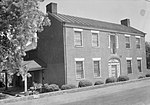Miami Valley Christian Academy
Christian schools in OhioHigh schools in Hamilton County, OhioNondenominational Christian schools in the United StatesPrivate elementary schools in OhioPrivate high schools in Ohio ... and 1 more
Private middle schools in Ohio
Miami Valley Christian Academy is a private, non-denominational Christian school located on the east side of Cincinnati in Newtown, Ohio, United States. MVCA educates children aged Preschool - 12th Grade. The curriculum provides college preparatory academic instruction from a Biblical worldview. Fine arts, athletics, and other co-curriculars complement their core subjects.
Excerpt from the Wikipedia article Miami Valley Christian Academy (License: CC BY-SA 3.0, Authors).Miami Valley Christian Academy
Short Park Trail,
Geographical coordinates (GPS) Address External links Nearby Places Show on map
Geographical coordinates (GPS)
| Latitude | Longitude |
|---|---|
| N 39.129166666667 ° | E -84.360555555556 ° |
Address
Miami Valley Christian Academy
Short Park Trail
45227
Ohio, United States
Open on Google Maps







